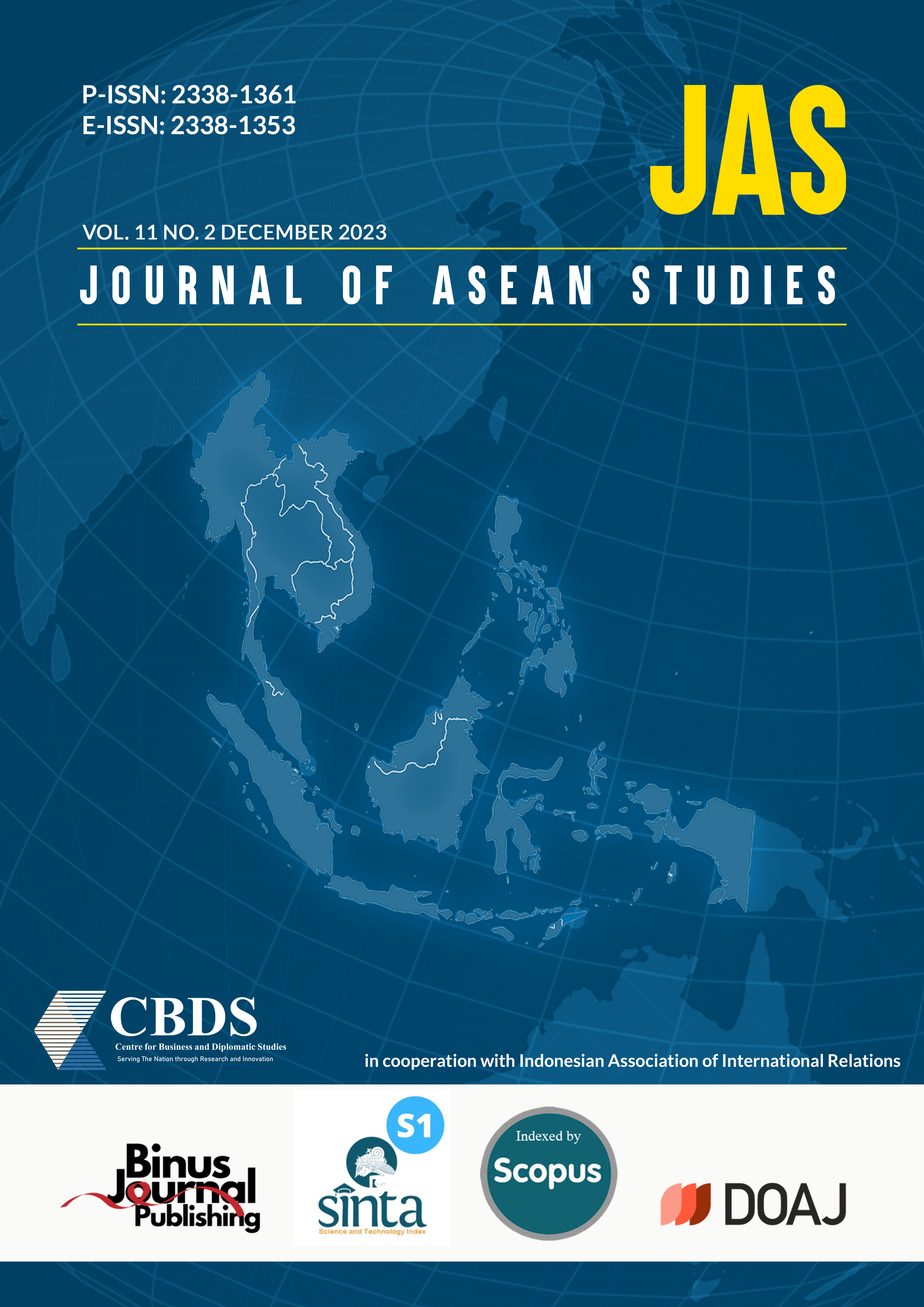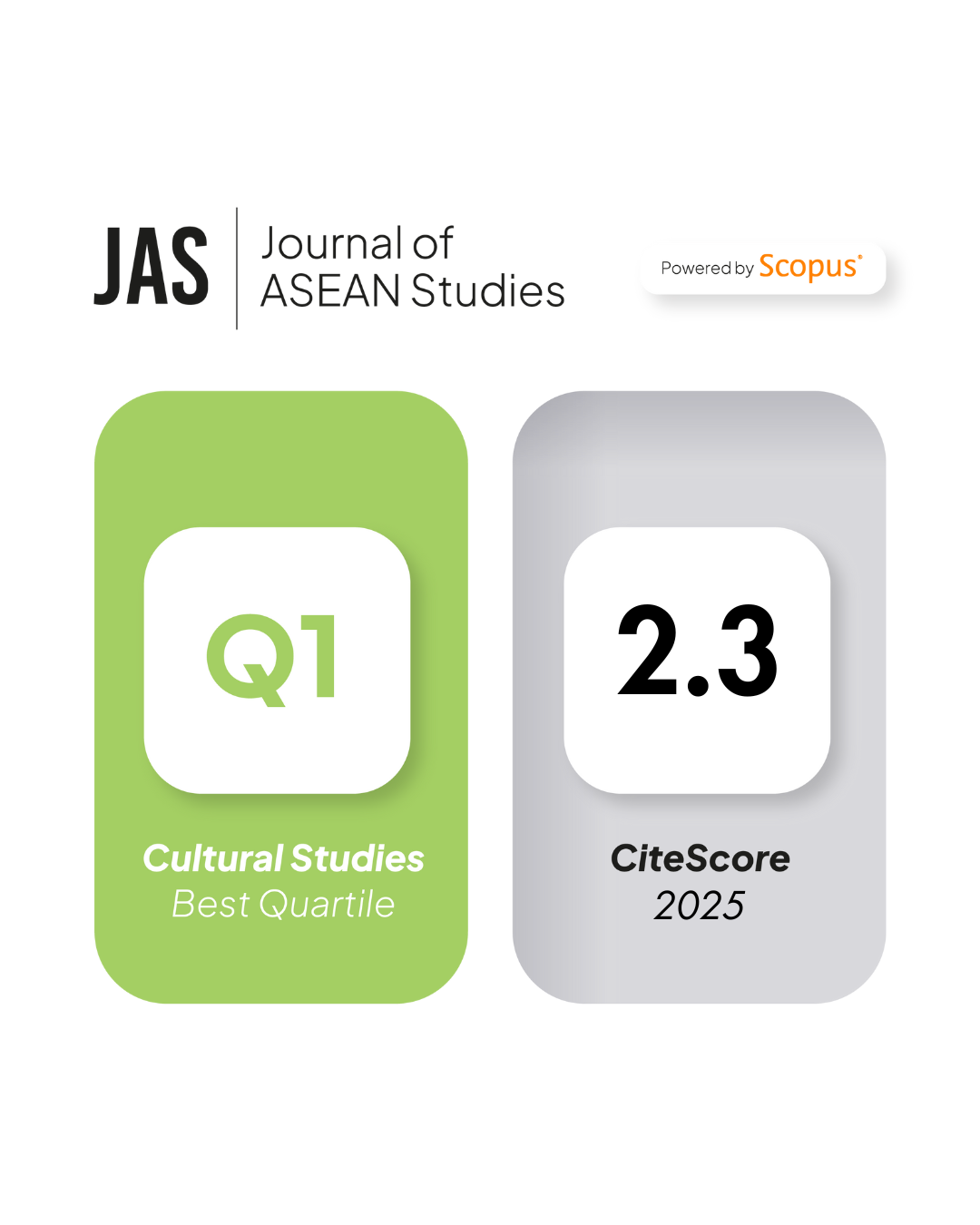New Thoughts on Formation of Tourism Perceived Images: An Investigation of Guangxi’s Overseas Chinese Students from ASEAN
DOI:
https://doi.org/10.21512/jas.v11i2.9706Keywords:
cultural attachment, ASEAN, perceived images, international studentAbstract
The research attempts to explain the psychological formation of the image of the sojourn by overseas students who are culturally homogeneous with the sojourn by constructing a comprehensive framework for the composition of the perceived image that contains the new dimension of cultural attachment. In particular, a group of 482 overseas Chinese students from ASEAN with learning experience in Guangxi are the respondents, benefiting from the deep ties between their ethnic and cultural backgrounds with mainland China. It is a strategic consideration based on Guangxi’s international tourism market and image promotion for ASEAN. The research uses quantitative analysis to combine the external influences previously supported in the literature, cultural attachment, and Cognitive-Affective-Conative (CAC) three-dimensional perceived image framework into a more comprehensive model to conduct a hypothetical-deductive study. The results of the quantitative analysis consolidate to a certain extent that the internal constitutive conditions of perceived image are promoted by the CAC model and further test the influence of perceived image under the combined effect of internal and external factors. Meanwhile, it is confirmed that cultural attachment has a strong role in the formation of the perceived image of a specific tourist group. The overall conclusions of the research are rich in academic significance and represent a theoretical expansion of the destination marketing system in response to real-world needs.
References
Agapito, D., Oom do Valle, P., & Da Costa Mendes, J. (2013). The cognitive-affective-conative model of destination image: A confirmatory analysis. Journal of Travel & Tourism Marketing, 30(5), 471–481. https://doi.org/10.1080/10548408.2013.803393
Agapito, D., Pinto, P., & Mendes, J. (2017). Tourists’ memories, sensory impressions and loyalty: In loco and post-visit study in Southwest Portugal. Tourism Management, 58, 108–118. https://doi.org/10.1016/j.tourman.2016.10.015
Alcañiz, E. B., GarcÃa, I. S., & Blas, S. S. (2009). The functional-psychological continuum in the cognitive image of a destination: A confirmatory analysis. Tourism Management, 30(5), 715–723. https://doi.org/10.1016/j.tourman.2008.10.020
Asuero, A. G., Sayago, A., & González, A. G. (2006). The correlation coefficient: An overview. Critical Reviews in Analytical Chemistry, 36(1), 41–59. https://doi.org/10.1080/10408340500526766
Bahkia, A. S., Awang, Z., Afthanorhan, A., Ghazali, P. L., & Foziah, H. (2019). Exploratory factor analysis on occupational stress in context of Malaysian sewerage operations. In AIP Conference Proceedings. AIP Publishing. https://doi.org/10.1063/1.5121111
Baloglu, S., & McCleary, K. W. (1999). A model of destination image formation. Annals of Tourism Research, 26(4), 868–897. https://doi.org/10.1016/S0160-7383(99)00030-4
Beerli, A., & MartÃn, J. D. (2004). Tourists’ characteristics and the perceived image of tourist destinations: A quantitative analysis—a case study of Lanzarote, Spain. Tourism Management, 25(5), 623–636. https://doi.org/10.1016/j.tourman.2003.06.004
Brown, L. (2009). The transformative power of the international sojourn: An ethnographic study of the international student experience. Annals of Tourism Research, 36(3), 502–521. https://doi.org/10.1016/j.annals.2009.03.002
Cheng, J. Y. S. (2013). China-ASEAN economic co-operation and the role of provinces. Journal of Contemporary Asia, 43(2), 314–337. https://doi.org/10.1080/00472336.2012.757430
Chu, Q., Bao, G., & Sun, J. (2022). Progress and prospects of destination image research in the last decade. Sustainability, 14(17), 1–21. https://doi.org/10.3390/su141710716
Correia, A., Oom do Valle, P., & Moço, C. (2007). Why people travel to exotic places. International Journal of Culture, Tourism and Hospitality Research, 1(1), 45–61. https://doi.org/10.1108/17506180710729600
Cronbach, L. J., & Shavelson, R. J. (2004). My current thoughts on coefficient alpha and successor procedures. Educational and Psychological Measurement, 64(3), 391–418. https://doi.org/10.1177/0013164404266386
Cudeck, R. (2000). Exploratory factor analysis. In Handbook of applied multivariate statistics and mathematical modeling (pp. 265–296). https://doi.org/10.1016/b978-012691360-6/50011-2
Esu, B. B. (2015). An analysis of the image of destination Cross River and effect on visitors’ future intentions. Journal of Hospitality Management and Tourism, 6(7), 80–89. https://doi.org/10.5897/jhmt2015.0158
Fakeye, P. C. & Crompton, J. L. (1991). Image differences between prospective, first-time, and repeat visitors to the Lower Rio Grande Valley. Journal of Travel Research, 30(2), 10–16. https://doi.org/10.1177/004728759103000202
Gartner, W. C. (1993). Image formation process. In M. Uysal & D. Fesenmaier (Eds.), Communication and channel systems in tourism marketing (pp. 191–215). Haworth Press.
Gartner, W. C. (1994). Image formation process. Journal of Travel & Tourism Marketing, 2(2-3), 191–216. https://doi.org/10.1300/J073v02n02_12
Gong, X. (2018). The Belt & Road Initiative and China’s influence in Southeast Asia. The Pacific Review, 32(4), 635–665. https://doi.org/10.1080/09512748.2018.1513950
Hahm, J., & Severt, K. (2018). Importance of destination marketing on image and familiarity. Journal of Hospitality and Tourism Insights, 1(1), 37–53. https://doi.org/10.1108/jhti-10-2017-0002
Hair, J. F., Anderson, R. E., Tatham, R. L., & Black, W. C. (2005). Análise multivariada de dados (5th ed.). Bookman.
Hong, Y. (2017). Cultural attachment theory. The International Encyclopedia of Intercultural Communication. https://doi.org/10.1002/9781118783665.ieicc0014
Hong, Y., Fang, Y., Yang, Y., & Phua, D. Y. (2013). Cultural attachment: A new theory and method to understand cross-cultural competence. Journal of Cross-Cultural Psychology, 44(6), 1024–1044. https://doi.org/10.1177/0022022113480039
Hossain, B., & Lamb, L. (2020). Cultural attachment and wellbeing among Canada’s indigenous people: A rural urban divide. Journal of Happiness Studies, 21, 1303–1324. https://doi.org/10.1007/s10902-019-00132-8
Hsu, C. H. C., Cai, L. A., & Mimi Li. (2009). Expectation, motivation, and attitude: A tourist behavioral model. Journal of Travel Research, 49(3), 282–296. https://doi.org/10.1177/0047287509349266
Hunt, J. D. (1975). Image as a factor in tourism development. Journal of Travel Research, 13(3), 1–7. https://doi.org/10.1177/004728757501300301
Japutra, A. (2020). The relations among attachment styles, destination attachment and destination satisfaction. Current Issues in Tourism, 23(3), 270–275. https://doi.org/10.1080/13683500.2019.1639640
Jarvis, J. (2020). ‘Study in Estonia’: The strategic implications of hosting international students on Estonia’s tourism economy. Journal of Baltic Studies, 51(2), 261–274. https://doi.org/10.1080/01629778.2018.1439847
Jeong, C., & Holland, S. (2012). Destination image saturation. Journal of Travel & Tourism Marketing, 29(6), 501–519. https://doi.org/10.1080/10548408.2012.701162
Keller, H. (2013). Attachment and culture. Journal of Cross-Cultural Psychology, 44(2), 175–194. https://doi.org/10.1177/0022022112472253
Kim, S., Lehto, X., & Kandampully, J. (2019). The role of familiarity in consumer destination image formation. Tourism Review, 74(4), 885–901. https://doi.org/10.1108/tr-10-2018-0141
Kim, S., Stylidis, D., & Oh, M. (2019). Is perception of destination image stable or does it fluctuate? A measurement of three points in time. International Journal of Tourism Research, 21(4), 447–461. https://doi.org/10.1002/jtr.2273
Kislali, H., Kavaratzis, M., & Saren, M. (2016). Rethinking destination image formation. International Journal of Culture, Tourism and Hospitality Research, 10(1), 70–80. https://doi.org/10.1108/ijcthr-05-2015-0050
Krejcie, R. V., & Morgan, D. W. (1970). Determining sample size for research activities. Educational and Psychological Measurement, 30(3), 607–610. https://doi.org/10.1177/001316447003000308
Lee, C. F., & King, B. (2016). International students in Asia: Travel behaviors and destination perceptions. Asia Pacific Journal of Tourism Research, 21(4), 457–476. https://doi.org/10.1080/10941665.2015.1062786
Liu, C. X. (2021). Overview on development of ASEAN traditional and herbal medicines. Chinese Herbal Medicines, 13(4), 441–450. https://doi.org/10.1016/j.chmed.2021.09.002
Liu, H. (2005). New migrants and the revival of overseas Chinese nationalism. Journal of Contemporary China, 14(43), 291–316. https://doi.org/10.1080/10670560500065611
Liu, X., Li, J., & Kim, W. G. (2017). The role of travel experience in the structural relationships among tourists’ perceived image, satisfaction, and behavioral intentions. Tourism and Hospitality Research, 17(2), 135–146. https://doi.org/10.1177/1467358415610371
Luo, T., Mohamed, A. E., & Yusof, N. S. (2023). The effect of cultural attachment on perceived image of sojourn destination: An evidence from Chinese descent students of ASEAN coming to Guangxi, China. International Journal of Professional Business Review, 8(4), 1–19. https://doi.org/10.26668/businessreview/2023.v8i4.1480
McDonald, J. H. (2014). Handbook of biological statistics (3rd ed.). Sparky House Publishing.
Milman, A. (1998). The impact of tourism and travel experience on senior travelers’ psychological well-being. Journal of Travel Research, 37(2), 166–170. https://doi.org/10.1177/004728759803700208
Oksenberg, L., Cannell, C., & Kalton, G. (1991). New strategies for pretesting survey questions. Journal of Official Statistics, 7(3), 349–365. https://www.proquest.com/openview/ed8c6deba86be86efdff0d32f74d5521/1?pq-origsite=gscholar&cbl=105444
Papadimitriou, D., Apostolopoulou, A., & Kaplanidou, K. (2013). Destination personality, affective image, and behavioral intentions in domestic urban tourism. Journal of Travel Research, 54(3), 302–315. https://doi.org/10.1177/0047287513516389
Pike, S., & Ryan, C. (2004). Destination positioning analysis through a comparison of cognitive, affective, and conative perceptions. Journal of Travel Research, 42(4), 333–342. https://doi.org/10.1177/0047287504263029
Ramkissoon, H. (2015). Authenticity, satisfaction, and place attachment: A conceptual framework for cultural tourism in African island economies. Development Southern Africa, 32(3), 292–302. https://doi.org/10.1080/0376835x.2015.1010711
Sánchez-Rivero, M., & Pulido-Fernández, J. I. (2011). Testing heterogeneous image in cultural/non-cultural tourism markets: A latent model approach. International Journal of Tourism Research, 14(3), 250–268. https://doi.org/10.1002/jtr.850
Santana, L. D., & Sevilha Gosling, M. D. (2018). Dimensions of image: A model of destination image formation. Tourism Analysis, 23(3), 303–322. https://doi.org/10.3727/108354218x15305418666940
Shani, A., Chen, P. J., Wang, Y., & Hua, N. (2010). Testing the impact of a promotional video on destination image change: Application of China as a tourism destination. International Journal of Tourism Research, 12(2), 116–133. https://doi.org/10.1002/jtr.738
Silva, C., Kastenholz, E., & Abrantes, J. L. (2013). Place-attachment, destination image and impacts of tourism in mountain destinations. Anatolia, 24(1), 17–29. https://doi.org/10.1080/13032917.2012.762312
Smith, W. W., Li, X., Pan, B., Witte, M., & Doherty, S. T. (2015). Tracking destination image across the trip experience with smartphone technology. Tourism Management, 48, 113–122. https://doi.org/10.1016/j.tourman.2014.04.010
Stylidis, D. (2020). Residents’ destination image: A perspective article. Tourism Review, 75(1), 228–231. https://doi.org/10.1108/TR-05-2019-0191
Stylidis, D., Woosnam, K. M., Ivkov, M., & Kim, S. S. (2020). Destination loyalty explained through place attachment, destination familiarity and destination image. International Journal of Tourism Research, 22(5), 604–616. https://doi.org/10.1002/jtr.2359
Stylos, N., Bellou, V., Andronikidis, A., & Vassiliadis, C. A. (2017). Linking the dots among destination images, place attachment, and revisit intentions: A study among British and Russian tourists. Tourism Management, 60, 15–29. https://doi.org/10.1016/j.tourman.2016.11.006
Tang, Y. (2013). Travel motivation, destination image and visitor satisfaction of international tourists after the 2008 Wenchuan earthquake: A structural modelling approach. Asia Pacific Journal of Tourism Research, 19(11), 1260–1277. https://doi.org/10.1080/10941665.2013.844181
Tasci, A. D. A. (2007). Assessment of factors influencing destination image using a multiple regression model. Tourism Review, 62(2), 23–30. https://doi.org/10.1108/16605370780000311
Tasci, A. D. A., Gartner, W. C., & Tamer Cavusgil, S. (2007). Conceptualization and operationalization of destination image. Journal of Hospitality & Tourism Research, 31(2), 194–223. https://doi.org/10.1177/1096348006297290
Veasna, S., Wu, W. Y., & Huang, C. H. (2013). The impact of destination source credibility on destination satisfaction: The mediating effects of destination attachment and destination image. Tourism Management, 36, 511–526. https://doi.org/10.1016/j.tourman.2012.09.007
Woosnam, K. M., Stylidis, D., & Ivkov, M. (2020). Explaining conative destination image through cognitive and affective destination image and emotional solidarity with residents. Journal of Sustainable Tourism, 28(6), 917–935. https://doi.org/10.1080/09669582.2019.1708920
Wu, X., & Chan, W. K. (2019). Integrating international student mobility in the Belt and Road Initiative: From state-dominated to state-steering? Higher Education Evaluation and Development, 13(1), 33–47. https://doi.org/10.1108/heed-03-2019-0010
Yap, W. J., Christopoulos, G. I., & Hong, Y. Y. (2017). Physiological responses associated with cultural attachment. Behavioural Brain Research, 325, 214–222. https://doi.org/10.1016/j.bbr.2017.01.017
Yilmaz, Y., Yilmaz, Y., İçigen, E. T., Ekin, Y., & Utku, B. D. (2009). Destination image: A comparative study on pre and post trip image variations. Journal of Hospitality Marketing & Management, 18(5), 461–479. https://doi.org/10.1080/19368620902950022
Downloads
Published
How to Cite
Issue
Section
License
Copyright (c) 2023 Tianyang Luo, Ahmad Edwin Mohamed, Noor Suhaila Yusof

This work is licensed under a Creative Commons Attribution-NonCommercial 4.0 International License.






















